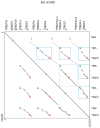The Organization of the Pig T-Cell Receptor γ (TRG) Locus Provides Insights into the Evolutionary Patterns of the TRG Genes across Cetartiodactyla
- PMID: 35205222
- PMCID: PMC8872565
- DOI: 10.3390/genes13020177
The Organization of the Pig T-Cell Receptor γ (TRG) Locus Provides Insights into the Evolutionary Patterns of the TRG Genes across Cetartiodactyla
Abstract
The domestic pig (Sus scrofa) is a species representative of the Suina, one of the four suborders within Cetartiodactyla. In this paper, we reported our analysis of the pig TRG locus in comparison with the loci of species representative of the Ruminantia, Tylopoda, and Cetacea suborders. The pig TRG genomic structure reiterates the peculiarity of the organization of Cetartiodactyla loci in TRGC "cassettes", each containing the basic V-J-J-C unit. Eighteen genes arranged in four TRGC cassettes, form the pig TRG locus. All the functional TRG genes were expressed, and the TRGV genes preferentially rearrange with the TRGJ genes within their own cassette, which correlates the diversity of the γ-chain repertoire with the number of cassettes. Among them, the TRGC5, located at the 5' end of the locus, is the only cassette that retains a marked homology with the corresponding TRGC cassettes of all the analyzed species. The preservation of the TRGC5 cassette for such a long evolutionary time presumes a highly specialized function of its genes, which could be essential for the survival of species. Therefore, the maintenance of this cassette in pigs confirms that it is the most evolutionarily ancient within Cetartiodactyla, and it has undergone a process of duplication to give rise to the other TRGC cassettes in the different artiodactyl species in a lineage-specific manner.
Keywords: Cetartiodactyla; TRG genes; TRG locus; evolution; immunogenomics; pig genome; γ/δ T-cell; γ/δ high species.
Conflict of interest statement
The authors declare no conflict of interest.
Figures






References
-
- Hall E.R., Simpson G.G. The Principles of Classification and a Classification of Mammals. J. Mammal. 1946;27:287–288. doi: 10.2307/1375443. - DOI
-
- IUCN The IUCN Red List of Threatened Species. 2018. [(accessed on 20 December 2021)]. Version 2018–2. Available online: http://www.iucnredlist.org.
Publication types
MeSH terms
Substances
LinkOut - more resources
Full Text Sources

